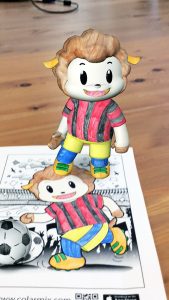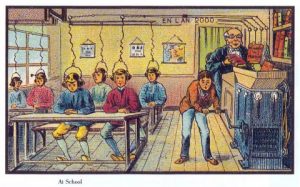Winn (2003) introduces a new “conceptual framework for studying learning in artificial environments” (abstract), which I’ve dubbed E2A, standing for Embodiment, Embeddedness, and Adaptation. These three concepts, he proposes, are to be taken holistically and provide a theoretical framework for considering how learning occurs from the perspective of cognitive neuroscience and systems theory. E2A considers how to explain how learning occurs when students work with “complex, computer-supported simulations of natural environments, referred to as ‘artificial environments’” (Winn, 2003, abstract).
Winn (2003) creates deliberate distance between E2A and several key aspects of constructivism. When educational researchers moved away from a computational view of learning, most sought answers through studying the contexts of learning under the umbrellas of “situated cognition” and “constructivism” but others began to study the act of learning as a result of adaptations between students and their environment which they viewed as a kind of complex system, thus applying principles of “systems theory” in their explanation of how the human mind learns. These educators turned to explanations for cognition related to the neurosciences, stating that “explanations of learning and cognition can be reduced no further than those emerging from the cognitive neurosciences” regardless of how complex directly describing and analysing learning processes proves when taking this paradigm as the starting point (Winn, 2003, p.3). These researchers propose an alternative framework to constructivism “based on the assumption that learning occurs when people adapt to their environment” wherein the learner is both embedded and physically active (Winn, 2003, p.3). From this arises the claim that cognition can be thought of as an “embodied” as well as a “cerebral” activity. Proponents of E2A take issue not with constructivism’s epistemelogical premise, but with its conclusions, citing it leans “dangerously towards solipsism” (p.12). Thus, “we arrive at a description of learning that is quite different from accounts given by traditional cognitive psychology and constructivism…The framework brings together recent research and theory that extend the purview of cognitive activity from the brain, through the body, to the environment itself” (p.22). Although Winn (2003) and other E2A proponents agree with constructivists that “cognition activity depends on the context in which it takes place” (p.5), they locate the construction of mental models (referred to as mental representations) in the scientific actions within the brain, via cognitive neuroscience, rather than occurring without attempted explanation of the phenomena by constructivists.
The foundation for this conceptual framework is the proposed cementing of three, previously separate ideas, into one “completely interdependent” self-organizing system:
(1) Cognition is embodied in physical activity which is,
(2) Embedded in an environment specifically designed to create learning, but that
(3) Learning does not occur passively or merely mentally, rather learning is the result of the “adaptation of the learner to the environment and the environment to the learner” (Winn, 2003, abstract).
The Four Learning Models & TELEs in E2A
I was intrigued by the theory of embodied learning and, although it stands apart from the metaphysical conclusions of constructivism, I sought to connect it to those previous learning frameworks from Module B. The concept of the body as our first STEM manipulative is a compelling one but I believe this goes beyond the simple (yet very valuable) truth that moving parts of the body in gesture or moving around in a physical space to literally embody the concepts of an object in motion are excellent, and under-utilized, ways to help students gain a more comprehensive understanding of STEM concepts. This description is only one way in which learning can be understood as “embodied” (Winn, 2003, p.11).
The concept of environment, specifically the environment-of-perspective referred to by Winn (2003) as the Umwelt lends a powerful hand to the case for artificial environments in learning. It is here that I began to see the connections of E2A to the other learning frameworks. “Beyond scaffolding (Linn, 1995), we can now embed pedagogical strategies into the very fabric of the environment. Since learning arises from adaptation to the environment, it can be guided by the behavior of the environment itself” (Winn, year, p.23). E2A therefore, seems to take SKI through the affordances of the WISE TELE as its starting point and then build upon that so that the technology is not simply the skeleton of the knowledge building experiences but actually couples the student within the artificial environment until that Umwelt actually becomes those experiences. “Learning is considered to arise from the reciprocal interaction between external, embodied, activity and internal, cerebral, activity, the whole being embedded in the environment in which it occurs. Learning is no longer confined to what goes on in the brain” (Winn, 2003, p.22).
The role and value of artificial environments are elevated when adopting this theory because the concept of embedded embodiment as the medium through which cognition (aka thinking) occurs is constrained by the limitations of our physical bodies. “The bandwidth of the data we can detect in the environment is limited” in terms of what a human can experience of light and sound and scales of space and time (Winn, 2003, p.7). However, such limitations can be reduced by the advances of artificial environments used as simulations of our natural environment. “Artificial environments can use computer technology to create metaphorical representations in order to bring to students concepts and principles that normally lie outside the reach of direct experience” (p.7). Using artificial environments such as a TELE is desirable, therefore, for an E2A pedagogy of learning. Dealing with misconceptions to create truer learning, they suggest using similuations to so what practitioners of TGEM do, that is, “to persuade students to reject such misconceptions and scientifically accurate conceptions in their place” (p.16) by actively propelling students into their Zone of Proximal Development through the deliberately timed release of confirming and confounding examples. As an example of a TELE, he referenced a really interesting looking (Minecraft-esque) study prepared for a PhD dissertation by S.L. Gabert 2001 called Phase World of Water where the author designs a VR environment for college students to explore a 3D graph of state of matter changes: Students’ VR avatars move through the 3 axis which aids students in developing deeper understanding of temperature, pressure, and volume in changes of state.
Winn (2003) draws on Hedden’s work on computer game design strategies which references Lepper and Malone’s theory of motivation that proposes the deliberate “direction of attention [through] challenge, curiosity, and fantasy” creates a circumstance called “flow” which corresponds to the “engagement, immersion and enjoyment” characterized by coupling or “presence”. They claim that these strategies in cognitively-driven virtual environments, as opposed to affectively-driven gaming envorinments, promote challenge and curiousity but “do not encourage fantasy” (p.18) but I disagree. I believe that the use of narrative is actually a better description of “fantasy”, in that it is the deliberate creation of a sense of “story” whether the ability to envision a real or imaginary setting, Puget Sound or a game world, and use the imagination to place oneself within that setting that is part of the draw of the narrative, a compelling sense of “place and time”, as well as of “character” or “events”. Everything students are doing in Virtual Puget Sound relies on the fantasy narrative in that the students are embedded within an Umwelt designed to evoke inquiry that is not actually the external, real life, environment. This is fundamentally no different than the narrative that is utilized in the Jasper series wherein students are invited to participate.
Winn (2003) cites recent suggestions that the term “embedded” is too passive, suggesting the student is being passively carried along by changes in the environment and, at least where participation in an artificial environment is concerned, is more accurately described by the concepts of “coupling”, “presence”, and “flow” between the student and the Umwelt, as is deliberately done by video game designers who program for affective (emotional) connectedness keeping players “engaged with their products for extended periods of time” (p.14). When it comes to the ability to describe cognitive processes and learning therefore, passivity is counterproductive because “successful students are anything but passive”. If successful coupling of learner to Umwelt (which she likens to the interconnectedness one might experiences when trying to catch a hamster with a pair of tongs) occurs “students can learn in an artificial environment in the same way that they learn in the natural world — intuitively, constructively and actively” (p.14).
Unsurprisingly, virtual immersion (ie. through VR HUDs rather than desktop computer simulations) increases presence because it increases coupling and thus cognitive gains increase proportionally. “Exposure to an environment can lead to physical changes in the brain, resulting in heightened perceptual sensitivity, which leads a person to actually see things differently in the environment” and enables students to “make distinctions [among objects and phenomena in the environment] with more certainty” (p.18). Examples given in support of this include Inuit seeing differences in snow, chicken sexers, or professional beer tasters heightened perceptions. “We have seen that tight coupling between a student and a learning environment leads to change in both the student and the environment. Adaptation is mutual” (p.20).
Winn (2003) brings out a really powerful idea by Varela et al. (1991) that “all of cognition is ‘enactive'” in the sense that “the way we organize ideas directly reflects how we act in the world” suggesting a “view of cognition that is based, not on the idea that the mind is a mirror of the environment, but that cognition consists of the constant, reciprocal, interaction between the mind and the environment” (Winn, 2003, p.11, emphasis added). All in all, E2A is a very powerful vehicle for considering human cognition and I believe it has significant applications to guiding pedagogical choices for educators.
Questions
(1) In what other ways is E2A different from the constructivist epistemology we’ve studied in MET thus far?
(2) Which of the theories in Module B best fit within an E2A framework, in your opinion?


